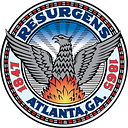Atlanta’s airport gives glimpse into city’s growth, legacy
Hartsfield-Jackson is home to many historical treasures that may be unexpected or go overlooked to those rushing through Atlanta’s airport.
Several artifacts, mementos and exhibits honoring the city’s history and pivotal role in the civil rights movement are on display along the corridors of the airport, one of the busiest in the world.
District 12 Council member Antonio Lewis, who represents the Atlanta area that encompasses the airport, said the displays, which include an extensive look at the growth of the city and Atlanta’s Black middle class, shine a wonderful light on the community.
“I think it’s one of the most beautiful museums in the world,” Lewis said. “I actually walk through it every time and don’t get on the train because I like seeing it.”
The exhibits include several pieces highlighting the lives of some of Atlanta’s most recognizable and historic figures, including Dr. Martin Luther King Jr. and Congressman John Lewis.
“The airport’s museum gives the history of Atlanta,” Lewis said. “It shows how the airport was built and the pioneers that helped to build this beautiful city. It’s a beautiful thing.”
He noted that as a transportation hub, the airport is a logical and valuable place to have these exhibits on display.
“The more you know about Atlanta, the more you know we have controlled transportation,” Lewis said, noting the city’s founding and growth as a railway hub. “Everything was done intentionally.”
By 1957, Atlanta was the nation’s busiest airport with more than two million passengers annually, according to the Atlanta History Center. In 1971, the city renamed the airport after former Mayor William B. Hartsfield, who helped steer the early growth of the airport. In 2003, the city added the name of Mayor Maynard Jackson, who led the rebuilding of the airport in the 1970s and helped set the stage and develop the ability for minority entrepreneurs to participate in the multitude of business transactions and vending opportunities at the airport.
Lewis added that Atlanta’s history and the displays at the airport reinforce the importance of trust in the community and the vision of Mayor Jackson.
“That museum wouldn’t be there if it wasn’t for Maynard Jackson and the efforts he made. Because of that, our airport has been able to continue to grow,” he said.
District 2 Council member Amir Farokhi, chair of the Council’s Transportation Committee, said this connection between the city’s growth and the airport are intertwined. He added that the displays are a terrific way to tell the city’s story.
“The exhibits not only tell the impact of figures like Dr. King and Congressman Lewis, but they humanize them in ways that could be hard to do just through a news story or a book,” Farokhi said. “Seeing their personal reflections, their time passing through the airport, all of these things remind us that in many ways, there is greatness in all of us. Sometimes, all that it takes is summoning our courage to speak up and act.”
He noted that he would encourage visitors at the airport to pause and take in the exhibits.
“The airport could choose to put countless business enterprise ads up along the corridors, but they have chosen to include a pretty remarkable cultural and artistic component to our airport — and that’s special,” Farokhi said.
